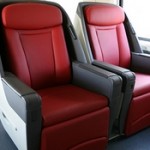DIAB Materials used for lightweight seats on CRH380A and B Projects
Originally designed for first-class passenger cabins on commercial jets, a unique aerospace seat concept sparked the imagination of Shanghai Yuantong, a components supplier specialized in various seats. Now, the company has reimagined and developed these sumptuous seats for VIP seating on selected CRH380A & B projects, which is the fastest designed speed train in China.
With a sleek and lightweight design, the seats offer comfortable and ergonomically correct seating. Although more important on an airplane, reduced weight benefits train traffic as well. Shanghai Yuantong’s seats are made of materials that provide superior comfort while reducing overall product weight. However, the design does not compromise sturdiness and durability. Protecting the passenger’s privacy, the chair shell also supports the components of the entire structure.
Having worked with DIAB for three years, Shanghai Yuantong chose Divinycell P for the production of the seats. The lightest PET foam available on the market, Divinycell P significantly reduces the weight of the finished product. It also offers limited resin absorption and excellent FST property, which is able to meet the regulation of the locomotive requirement (DIN5510). Together with its compatibility with RTM and outstanding tooling ability, Divinycell P was simply the natural choice for the project. The material is machined on a 3-axial CNC machine and assembled into the required 3D shape. The core is then installed into the RTM mold with fiberglass and impregnated with injected fire-resistant resin.
A result of market research and ergonomic studies, the Shanghai Yuantong seats are thoroughly tested. They combine function, comfort and durability — benefitting airplane passengers as well as train travelers.
Fonte: DIAB













